Cranial Cruciate Ligament (CCL) Tears in Dogs: Treating the Injury
A Common Leg Injury in Dogs
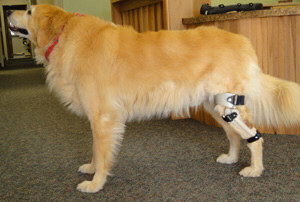 One of the most common leg injuries experienced by dogs is a cranial cruciate
ligament (CCL) tear, similar to an anterior cruciate ligament (ACL) injury in
humans. The anterior cruciate ligament is one of the primary ligaments in the
knee of human beings. One of the most common leg injuries experienced by dogs is a cranial cruciate
ligament (CCL) tear, similar to an anterior cruciate ligament (ACL) injury in
humans. The anterior cruciate ligament is one of the primary ligaments in the
knee of human beings.
Where the Cranial Cruciate Ligament (CCL) is Located?
In dogs, the CCL is located in the stifle (knee) joint of the back leg. When
the ligament ruptures, joint instability or lameness is typically the result.
Left untreated, the injury can lead to joint degeneration or further injury to
the connective tissues.
The joint of the stifle is stabilized and supported with four articular
ligaments, made up of the medial and lateral collateral ligaments on the outside
of the stifle. The caudal and cranial cruciate ligaments located within the
stifle itself.
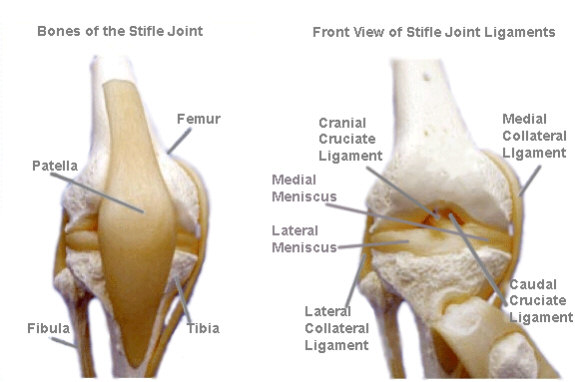
The CCL itself affixes to the femur (the large bone in the thigh), and spans
over the stifle joint before it connects to the tibia. The tibia and fibula are
bones located in the lower leg, with the tibia being the larger of the two
bones.
Between the tibia and femur is the meniscus. The meniscus is a cartilage
whose primary function is to absorb the impact created when a dog jumps or runs.
If you’ve ever heard of anyone complaining of a torn cartilage, the meniscus
represents this fibrous band in humans.
Dogs That are at a Greater Risk for Injury
 Again, injury to the CCL is one of the most prevalent orthopedic complaints
in veterinarian offices and is the most frequent cause of degeneration of the
stifle joint. Larger, overweight canines are more susceptible to a tear of the
CCL and the effects are much more severe; compensated pain for the size and
weight of the breed. While an injury can occur in all breeds and sizes of dogs,
it happens most often in such large breeds as: Again, injury to the CCL is one of the most prevalent orthopedic complaints
in veterinarian offices and is the most frequent cause of degeneration of the
stifle joint. Larger, overweight canines are more susceptible to a tear of the
CCL and the effects are much more severe; compensated pain for the size and
weight of the breed. While an injury can occur in all breeds and sizes of dogs,
it happens most often in such large breeds as:
- The Bullmastiff
- The Chow
- The German shepherd
- The Golden retriever
- The Labrador retriever
- The Saint Bernard
- The Rottweiler
Ruptures Related to Age
With respect to age, CCL ruptures occur most often in dogs aged from five to
seven years old, and are brought on by degeneration of the stifle joint. In
younger dogs, or those canines under four years of age, injury is the most
common reason for the tear. Again, large, younger dogs are much more likely to
sustain damage than smaller canine breeds are.
How an Injury Can Develop
An acute rupture or injury can suddenly occur when the ligament is twisted,
thereby causing the tissue to hyperextend or over-rotate. For example, if a dog
runs and, say, partially steps in a hole, then a tear can result. In older
animals, weakened tissues cause the joint to become unstable, resulting in a
partial tear. This partial tear subsequently leads to the larger injury.
Therefore, the risk for a CCL tear is greater in dogs that are older, or that
are larger or overweight. Dogs that have arthritis or exhibit abnormalities in
their gait, such as a luxating patella (floating kneecap) or bowleggedness, are
vulnerable to tendon tears as well.
Unfortunately, when the CCL becomes torn or ruptured, only the surrounding
tissues and muscles are left to keep the bones of the tibia, fibula, and femur
intact. Whether the damage is caused suddenly or by chronic repetitiveness, the
tear normally results in hind limb pain or lameness. Not only that, a dog that
uses its contralateral (uninjured) leg to compensate for the injury may cause
damage to the good leg as well. So, immediate measures should be taken to
correct the situation before it gets worse. The prospects for recovery
increasingly diminish the longer the problem is left unaddressed.
Planning a Course of Treatment
So, when a CCL tear is diagnosed, a dog should start to receive a course of
treatment as soon as possible. That can mean treating the dog with medications,
such as non-steroidal anti-inflammatory drugs (NSAIDs), for the pain and placing
certain restrictions on activity. The main objective of treating the injury is
to alleviate any discomfort, increase the stability and functioning of the
stifle joint, and decrease the chance for degenerative damage.
Surgery - The Most Reliable, if Not Effective, Cure
While a conservative treatment approach can be followed initially, surgery is
typically the most reliable cure and the ultimate treatment option in most
cases. That's because the cruciate ligament, if torn or overstretched, will not
heal or reattach unless surgery is performed. Several surgical procedures are
currently used to reconstruct or correct a torn CCL, depending on the nature and
severity of the injury.
Surgical Options for a CCL Injury
Generally, CCL procedures are designed to change the angle of the stifle
joint so a dog can bear weight more easily. The main surgery options include
tibial plateau leveling osteotomy (TPLO), tibial tuberosity advancement (TTA) or
triple tibial osteotomy (TTO).
TPLO (Tibial Plateau Leveling Osteotomy)
TPLO is a technique that alters the bones in the stifle joint so they are
more balanced. The surgeon begins the procedure by making a cut down the span of
the leg before removing the damaged ends of the CCL. An incision is then made at
the top of the tibia and the bone is measured.
TPLO Surgery:
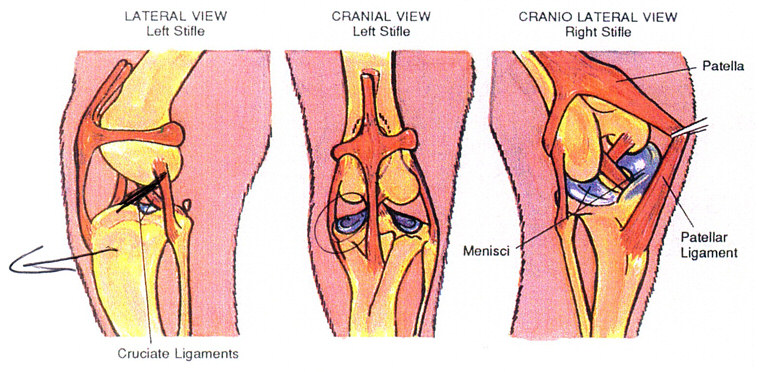
The flat part or plateau of the top portion of the bone is repositioned to
level out the slope of the knee. To keep the altered slope intact, a metal plate
is inserted. Generally, dogs can start bearing weight on their leg after a
couple weeks. After two months, indications of bone healing are evident and the
animal is well on its way to recovery.
TTA (Tibial Tuberosity Advancement)
TTA surgery, or tibial tuberosity advancement, is a technique that involves
manipulating the stifle joint to enhance stability. Therefore, the procedure
alters the angle of the bone in the stifle joint, or repositions the tibia. In
order to facilitate the process, the veterinary surgeon will make a four to six
inch incision along the stifle joint to gain entry to the CCL and, in some
cases, the meniscal cartilage. The tibia is then cut and positioned forward to
be removed after the bone has began healing.
TTA Surgery:
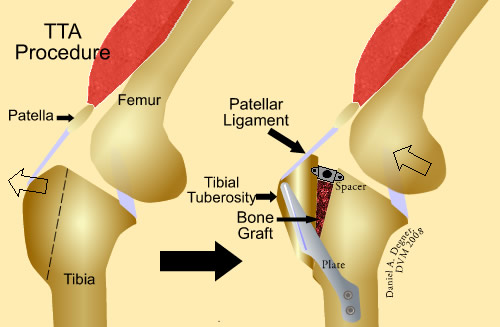
A couple weeks after the procedure, your dog should be using his leg much
more regularly. The bone should be healed in its entirety after two months'
time.
TTO (Triple Tibial Osteotomy)
|
Triple Tibial Osteotomy:
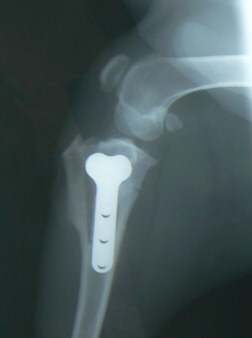
|
A TTO, short, again, for triple tibial osteotomy, is a combination of the
techniques used in TPLO and TTA procedures. The procedure involves making an
incision into the tibial bone to alter the stifle joint's angle. During the
procedure, the veterinary surgeon makes three incisions into the tibia.
The cuts permit the vet to rotate the flat top part of the tibia, known as
the plateau, and move the tibial tuberosity (a bony projection on the top part
of the tibia) slightly forward. Thereafter, a metal plate is inserted to
maintain the new angle for the joint. Full healing takes place after about a
month and a half with your dog bearing some weight on the leg after two weeks.
Chondroprotective Agents
Rehabilitation and physical therapy should be incorporated gradually to
ensure complete healing and to prevent reinjury. After any surgical procedure, a
dog typically is given NSAIDs or other supplements or medications to promote the
repair of the cartilage. Supplements used for this purpose are called
chondroprotective agents. The agents are available over-the-counter and by
prescription and are recommended for keeping joints and cartilages lubricated.
The remedies are also beneficial in relieving pain and inflammation. Examples of
chondroprotective agents include:
- Vitamin C
- Hyaluronan
- Omega 3 and 6 Fatty Acids
- Polysulfated glycosaminoglycans
- Chondroitin Sulfate
- Glucosamine
Preventative Measures and Recommendations
Dogs that are overweight that suffer from CCL damage often can obtain a good
deal of pain relief from losing weight. A regulated exercise program and healthy
diet can assist in stimulating cartilage growth in older animals as well. For
example, controlled, lengthy walks can help curtail the loss of muscle mass.
The following video further demonstrates the process:
After-surgery Care and Rehabilitation
After-surgery care often includes physical therapy in the form of
hydrotherapy (water exercise), or passive flexion and extension of the leg. A
dog should stay confined in one area of the house during the recovery period and
should only be walked if he needs to go outside at that time.
The following video further demonstrates flexion and extension therapy for
the leg:
After-surgery Prognosis
The prognosis for dogs that undergo surgery for tears to the CCL is
excellent. By stabilizing the stifle joint through surgical means and following
a course of rehabilitation, a dog that was formerly lame can walk again and
eventually use the once-injured limb.
Health Problems that Can Develop if Surgery is Not Undertaken
 Without undergoing surgery, a CCL rupture can cause osteoarthritis, muscle
atrophy or injury of the meniscus. Again, the risk of injuring the contralateral
limb (good leg) is further increased as that leg must bear the brunt of the load
for the injured leg. Without undergoing surgery, a CCL rupture can cause osteoarthritis, muscle
atrophy or injury of the meniscus. Again, the risk of injuring the contralateral
limb (good leg) is further increased as that leg must bear the brunt of the load
for the injured leg.
Fitting a Dog with a CCL Tear with an Orthopedic Brace: When it is
Recommended
However, another option, besides surgery, deserves notice too. Some
veterinarians recommend dogs with a CCL injury be fitted with an orthosis or
orthopedic brace. The brace is advised as an adjunct to surgery, to support
healing after surgery, or as a surgery alternative.
Good Candidates for Orthopedic Braces
Dogs that are advanced in years are often good candidates for orthopedic
braces as are dogs that are unable to tolerate anesthesia. The brace is an
option too when surgery is unaffordable.
As a temporary measure, orthopedic braces are recommended for dogs in the
following circumstances.
-
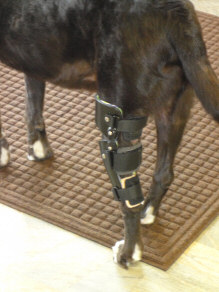 Dogs that need surgery which are too young for the repair can benefit
from wearing a brace in the interim. Dogs that need surgery which are too young for the repair can benefit
from wearing a brace in the interim.
- Dogs that have already undergone a procedure and require added support are
also good candidates for a brace to help alleviate some of the pressure and pain
related to having a CCL procedure or injury.
The Benefits of Orthopedic Braces
Orthopedic braces support injured joints and ligaments by allowing damaged
limbs to relax, thereby lessening fatigue and stress. In addition, an orthosis
is helpful in reducing swelling and discomfort and increasing a dog's confidence
in using his leg.
Besides CCL injuries, braces are used for injuries involving the hock or
carpus too. Orthopedic braces made for stifle joints replicate the functioning
of a healthy knee and assist in offloading it.
To customize a brace, a cast is made of the injured leg. A break-in period of
about a week is necessary for a dog to become accustomed to wearing the device.
Whether it is used as a post-surgery form of treatment or worn as an alternative
to surgery, it is a proven method of care.
An example of a dog wearing a stifle orthosis is shown in the following
video:
Pets
Top Lists:
18 Richest Animals in the World
15 Exotic Pets You Could Own Today
Top 20 Common Substances That Are Toxic to Cats and Dogs
Informational:
Animal Actors: Pets in the Film, TV, and Print Industry
Caring for a Yorkshire Terrier: Facts You Should Know
Caring for a Pig as a Pet: The Pot-bellied Pig and the Micro Pig
Difference Between a Cat Person And a Dog Person
Should You Microchip your Cat or Dog?
How to Raise and Care for Pygmy Goats
Caring for Unique Pets: The Leopard Gecko
Use Food-Grade Diatomaceous Earth to Kill Fleas Naturally
Dogs:
Top Lists:
Top 15 Dog Breeds For Home Protection
15 Fascinating Facts About The Mastiff
Informational:
How To Teach Your Dog to Hunt for Truffles
Caring for an English Bulldog: Tips and Basic Info
Cranial Cruciate Ligament (CCL) Tears in Dogs: Treating the Injury
How To Keep Your Dog free of Heartworm Disease
Dog With Separation Anxiety?
Cats:
Top Lists:
Top 6 Qualities in an Awesome Cat
Informational:
How to Control Fighting Felines
How to Get Your Cat to Exercise
Fish:
Fish 101 for the Hobbyist: The Fish’s Body and Senses
Buying a Saltwater Aquarium: What You Need to Know
Graduating to a Saltwater Tank
|